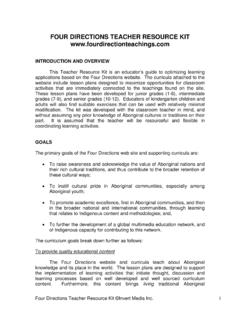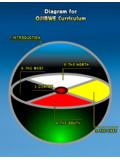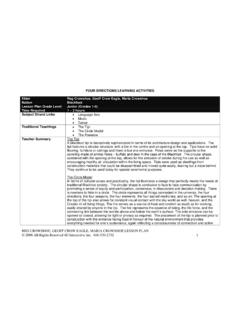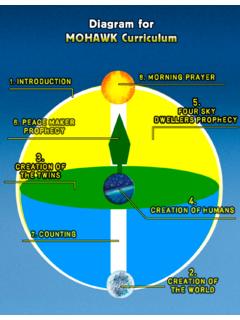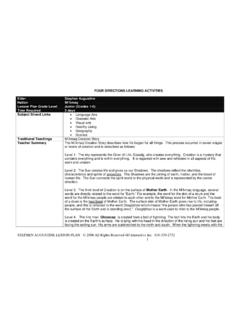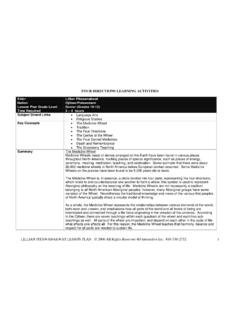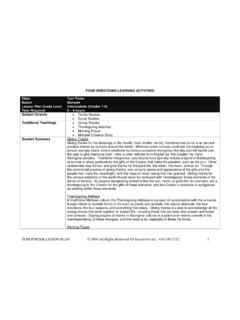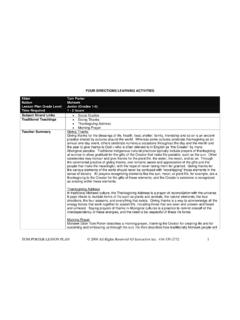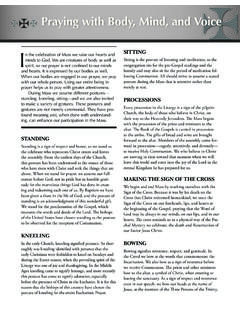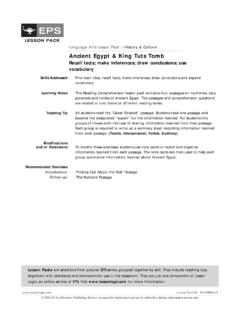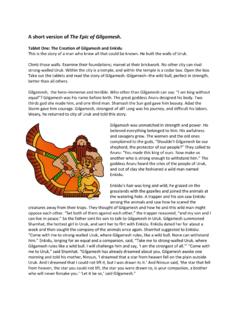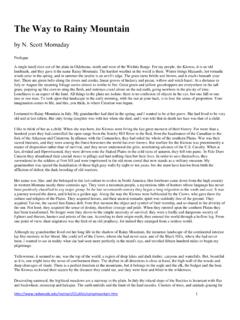Transcription of CREE (NEHIYAWAK) TEACHING - 2006
1 CREE ( nehiyawak ) TEACHING . ELDER: MARY LEE. INTRODUCTION. As Cree people, we were given the gift of being named for the four parts of human beings. nehiyawak , we were called. It means being balanced in the four parts that are found in the four directions of the Medicine Wheel. These four parts for human beings are the spiritual, physical, emotional and mental aspects of the self. We need to try and balance these four parts that were given to us, to function as people. The fire is in the centre of the Medicine Wheel.
2 That is where the meaning of the teachings comes from. For me this fire is also the self. When you look at the Medicine Wheel, you start from self. And as you look out, you make your circle. This is how the Medicine Wheel represents the life journey of people. The old people will tell you it is life itself. Look at the four seasons and follow the sun. Spring in the east, summer in the south, fall in the west and winter in the north. It tells the whole story of how all life came into being abundantly bright, rising in the east and then fading away as it moves west and north.
3 All life rises and sets like the sun. What we do in between is our journey. This is where the gifts of the four directions are needed - the gifts of the spirit, physical body, emotions and mind - and where we need to find balance within these four realms. Today, many people are out of balance because they tend to only favour two realms of self, the mental and the physical. They forget to look after their spiritual side, and often don't know how to express and deal with their emotions. People think that by showing anger they are expressing their emotions.
4 But that is not what it means to be emotional. Anger is a defense mechanism that protects the emotional part of us. The sensitive part of us is our emotional realm, the part that feels the truth about what's around us. But we'll show anger before we'll show that true part of ourselves because we have learned to be embarrassed by it. We'll get angry because that's accepted. Sadly, some people even think it is respected. But we won't show our true emotions, our vulnerability and sensitivity, because that is not accepted.
5 So we have learned to replace those things with anger. As for the spirit, there never seems to be enough time. People think you have to make a commitment of time through long periods of devotion to be spiritual. But 2006 All Rights Reserved 4D Interactive Inc. being spiritual is remembering. It is remembering that the first thing that was gifted to you when you came into being was the spirit. Sadly, we tend to forget that and then we neglect our spirit and take it for granted. So we need to remember where we came from and the gifts that were given to us as human beings.
6 This way of being in the world was taught to me by my mother through the teachings of making a tipi. The tipi teachings, as I call them today, relate to nurturing the four aspects of the self, the spiritual, physical, emotional and mental, which are rooted in the four directions. The tipi is also a symbol of the women, so in honour of my mother and great grandmother and Cree women everywhere, I will share some of these tipi teachings with you. CENTRE. The tipi teachings are passed on. When I talk about the teachings, it's not to alter or change them; I can only share how it was told to me.
7 There are many, many teachings that belong here with the tipi. I won't be able to share all of them with you. But in sharing a little bit of the meaning it is hoped that you will continue on your journey to seek the teachings that you require. You're never done learning. For us, the word tipi doesn't mean anything. There is a Cree word we use today;. we say migawap. But traditionally, when my mother was TEACHING me about the tipi, she would say Kitche Migawap. In the beginning, it didn't come in the shape of a tipi.
8 It came in the shape of a dome, which we still use today. It's known as a Sweat Lodge. When that lodge came to us, you couldn't make a fire in there. The people would gather the rocks outside, heat them up, and then bring them into a pit in the middle. This would keep them warm during the night. But they couldn't make a fire in there to cook. They had to do all their cooking outside. So when the lodge became bigger through the structure of the tipi, they could make a fire inside. My mother said that the women were named after that fire in the centre of the tipi, which brought that warmth and comfort.
9 In the Cree language, the centre, the fire, is iskwuptew. Woman in our language is iskwew, more than one woman, iskwewuk. We were named after that fire, iskwuptew, and that is very powerful, because it honours the sacredness of that fire. In our language, for old woman, we say, Notegweu. Years ago we used the term Notaygeu, meaning when an old lady covers herself with a shawl. A tipi cover is like that old woman with a shawl. As it comes around the tipi, it embraces all those teachings, the values of community that the women hold.
10 No matter how many children and great grandchildren come into that circle of hers, she always 2006 All Rights Reserved 4D Interactive Inc. still has room. And if you put it up right, the poles never show on the bottom, and that tipi stands with dignity, just as, years ago, women always covered their legs with the skirt, which also represents the sacred circle of life. And when you put the flaps up, it teaches you how we embrace life itself. It's like a woman standing there with her arms out, saying Thank you to everything.
